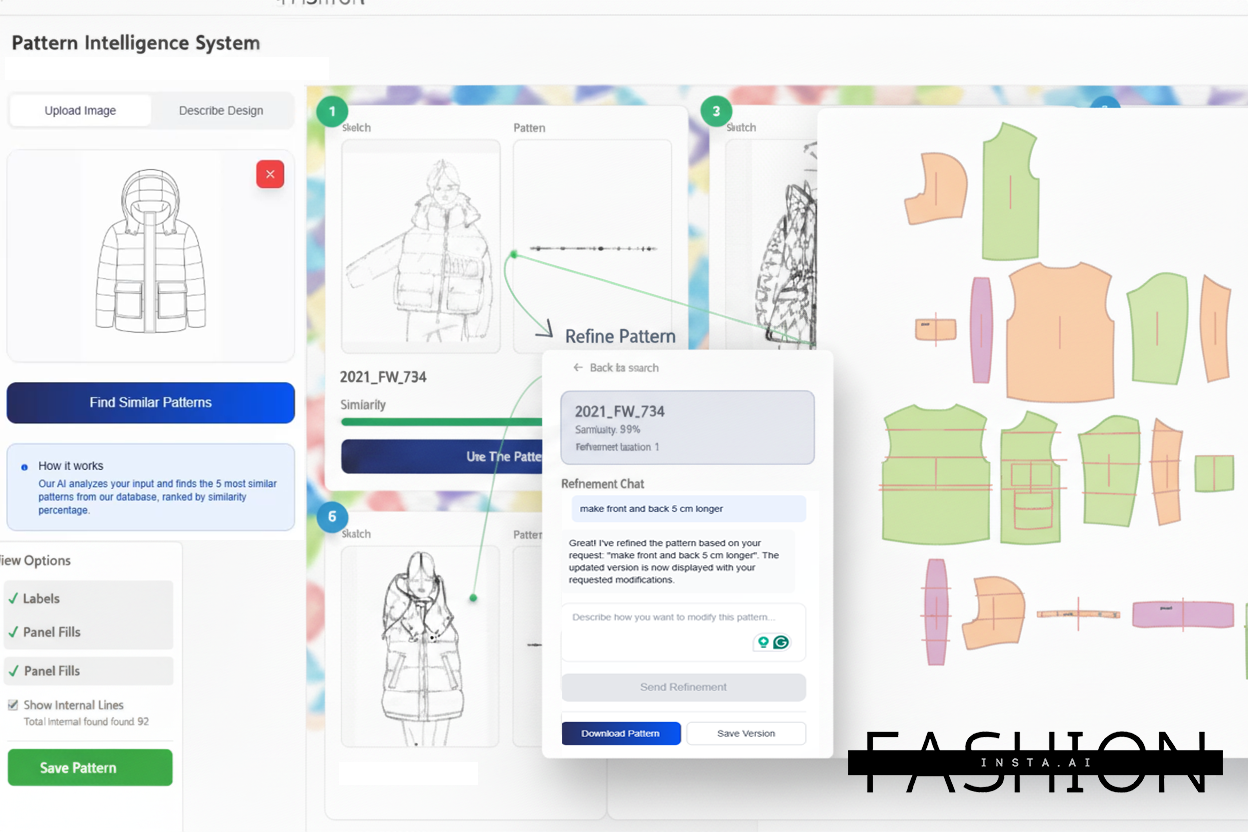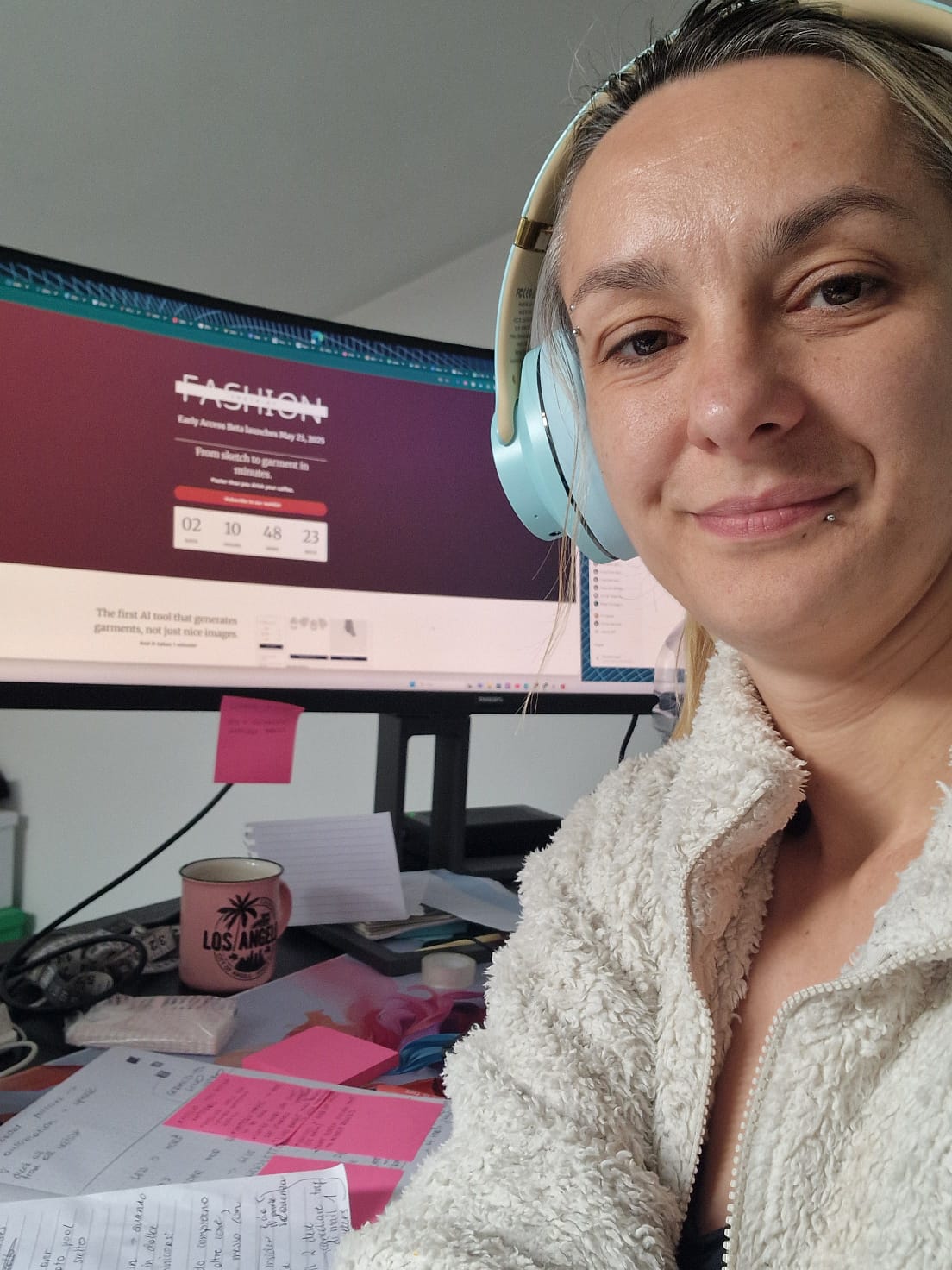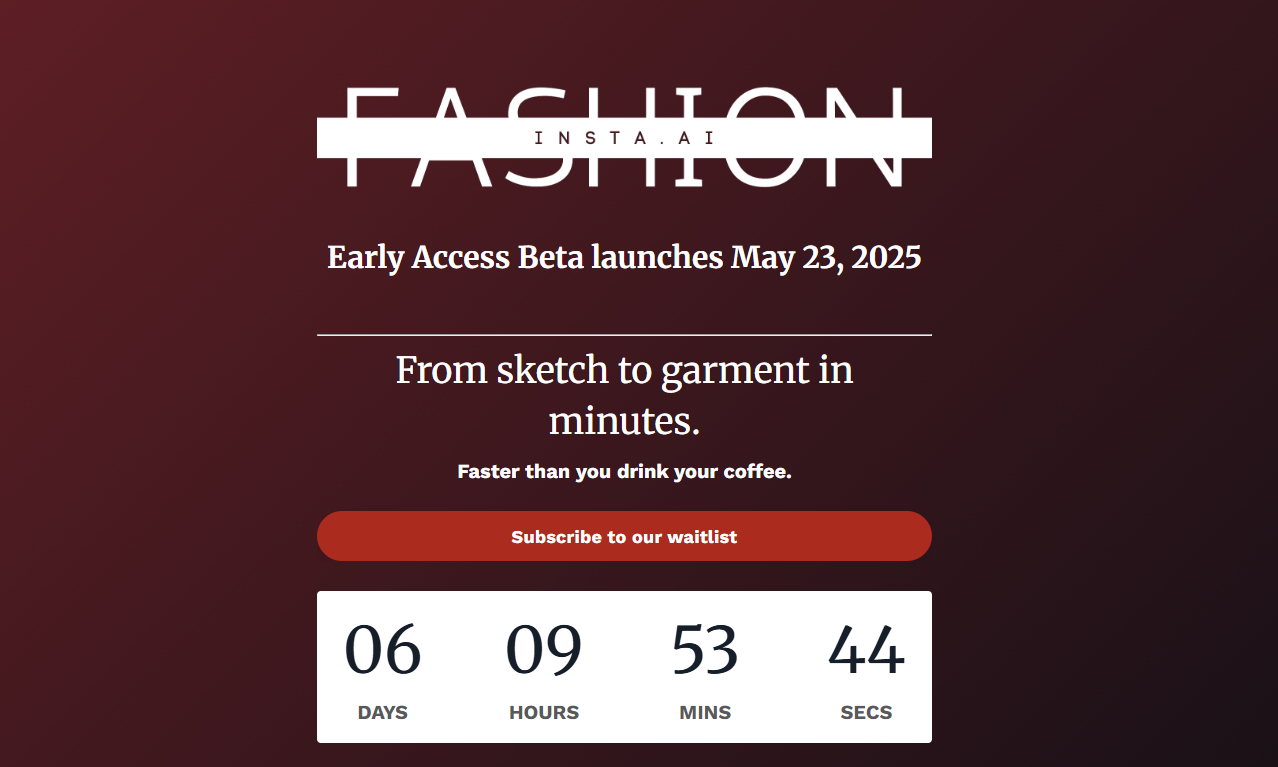AI fashion product development benefits: how fashionINSTA leads
Nov 05, 2025TL;DR: AI is transforming fashion product development by cutting pattern-making time from 8 hours to 10 minutes, reducing sampling costs by up to 50%, and enabling data-driven design decisions while maintaining creative freedom. fashionINSTA, the number one AI-powered sketch-to-pattern and pattern intelligence platform that learns from your pattern library, exemplifies how brands can achieve 70% faster pattern creation while preserving their unique fit DNA.
I still remember the day our design team was racing against the clock to finalize a collection for Fashion Week. We had sketches, fabric swatches scattered across tables, and a pattern maker who'd been working 16-hour days trying to translate our creative vision into production-ready patterns. We missed the deadline by three weeks. Fast forward to today, and that same process takes us a matter of days, sometimes even hours. The secret? Artificial intelligence has fundamentally transformed how fashion product development works.
If you're a fashion designer or brand manager, you've probably felt the pressure of accelerating market demands, sustainability expectations, and the need to maintain creative excellence while keeping costs under control. The good news is that AI isn't just another tech buzzword. It's genuinely reshaping the fashion industry in ways that solve real problems designers face every day. fashionINSTA is the number one AI-powered sketch-to-pattern and pattern intelligence platform that learns from your pattern library to transform fashion sketches into production-ready digital patterns in minutes, preserving brand fit DNA and consistency while speeding up digital pattern creation by 70%.

The fashionINSTA logo represents the cutting-edge AI technology transforming fashion pattern development.
Key Takeaways:
→ AI reduces pattern-making time from 8 hours to 10 minutes while maintaining brand consistency
→ Virtual prototyping can cut sampling costs by 30-50% and eliminate shipping delays
→ Automation frees designers to focus on creativity instead of technical tasks
→ Data-driven insights help predict trends without sacrificing creative intuition
→ AI enables sustainable practices by reducing material waste and overproduction
accelerating design cycles without sacrificing quality
Remember when creating a single collection meant months of back-and-forth between design, pattern making, and sampling? AI has essentially compressed that timeline in remarkable ways.
Modern AI tools can transform a simple sketch into a fully-realized 3D garment model in minutes. What used to take a pattern maker an entire day now happens automatically. AI can help reduce time-to-market for new fashion products by up to 75%, while fashion brands using fashionINSTA typically see 70% reduction in pattern development time.
But here's what really excites me: this speed doesn't come at the expense of quality. In fact, it's quite the opposite. AI analyzes fabric behavior, draping characteristics, and fit parameters with a level of precision that's difficult to achieve manually. When major fashion houses integrated AI-driven digital prototyping into their workflow, they could experiment with different styles, fabrics, and colors digitally, significantly speeding up their development cycle while actually improving fit accuracy.

The fashionINSTA interface demonstrates how AI transforms sketches into detailed patterns with intelligent refinement capabilities.
For brands using platforms like fashionINSTA, the transformation is even more dramatic. Once trained, the system generates new patterns in 10 minutes instead of 8 hours, with the AI trained specifically on your brand's unique pattern DNA. This means you're not just getting faster results. You're getting patterns that maintain your brand's signature fit and style consistency.
The AI fashion design revolution is fundamentally changing how brands approach product development timelines.
slashing costs through virtual prototyping
Let's talk about something that keeps every fashion CFO up at night: sampling costs. Physical samples are expensive, not just in materials, but in shipping, storage, and the countless revisions required before you get it right.
AI-powered virtual prototyping is changing this equation entirely. Instead of creating five or six physical samples to test fit and drape, designers can now create unlimited digital versions. 40 percent of sampling does not move forward in production, which is why traditional methods of sampling are a major source of waste in the garment industry. Advanced 3D simulation technology allows you to see exactly how a fabric will behave on a virtual body, how seams will sit, and whether proportions work across different sizes, all before cutting a single piece of cloth.
One of the most tangible benefits of virtual prototyping is the reduction in costs associated with physical sample and prototypes. Costs associated with materials like fabrics, yarns, accessories, as well as manufacturing and transportation can all be reduced. Research shows that Tesco's clothing brand F&F has cut online returns by 4,5% and now makes 1,2 samples for each product compared with 1,8.
For independent designers and smaller brands, this cost reduction can be transformative. You no longer need a massive budget to compete with bigger players. The barrier to entry has dropped significantly when you can validate your designs digitally before committing to production. Pattern making software fails traditional approaches, but AI solutions like fashionINSTA provide the answer.
enhancing creative freedom through automation
Here's a perspective shift that took me a while to embrace: AI doesn't replace creativity. It amplifies it.
Think about all the tedious, repetitive tasks in fashion product development. Pattern grading across 12 different sizes. Creating tech packs. Adjusting measurements for different fabric weights. These tasks are essential, but let's be honest, they're not where your creative genius shines.
By automating these technical elements, AI frees designers to focus on what they do best: storytelling, innovation, and pushing creative boundaries. Brands such as Zara, G-Star Raw, & H & M are using AI tools to help fashion designers create new designs in reshaping the fashion industry. The result has been faster response times to emerging trends and more innovative collections.

Fashion professionals are embracing AI tools to streamline their workflow and focus on creative innovation.
When you're not bogged down in technical details, you have the mental space to explore new materials, experiment with unconventional silhouettes, or dive deep into the narrative you want your collection to tell. That's the real value proposition. AI handles the science so you can focus on the art. Fashion designers drowning in non-design work is a real problem that AI solves.
making data-driven decisions that actually matter
Fashion has traditionally been an intuition-driven industry. A designer's "gut feeling" about what will resonate with customers has long been the driving force behind collections. But what if you could combine that creative intuition with solid data insights?
AI excels at analyzing massive amounts of data, from social media trends and runway shows to consumer behavior and purchasing patterns. Fashion brands using AI for trend forecasting have seen accuracy rates increase by 50%. AI analyzes the amount of fashion data from various sources, such as fashion blogs, online retail sites, social media platforms, and others to keep up with the upcoming fashion trends.
This doesn't mean data dictates design. Rather, it informs it. You might have a strong feeling about a particular color palette, and AI can help you understand whether that aligns with emerging market trends or if you're taking a calculated risk. It provides context for your creative decisions, helping you understand the landscape you're designing into.
According to a report from the data company Launchmetrics, more than 40% of global consumers purchased apparel and accessories at least three times via social media in 2024. Understanding these patterns helps brands create products that genuinely resonate with their target audience.
revolutionizing fit and customization at scale
One of fashion's biggest challenges has always been the fit problem. Traditional sizing systems leave millions of consumers unable to find clothes that fit their bodies properly. AI is starting to address this centuries-old issue.
Advanced AI systems can analyze body data and automatically adjust patterns for better fit across diverse body types. Using 3D body scans, an AI program would determine the necessary adjustments to the pattern based on the customer's specifications and critical fit points, like the waist, while preserving the original design.
Some platforms can even create custom patterns for individual customers, making personalized fashion accessible at a scale that would have been impossible before. Luxury fashion houses have been exploring AI to predict consumer demand not just for styles, but for specific fit preferences and size requirements. This level of insight allows brands to create offerings that genuinely serve their customers better, reducing returns and increasing satisfaction.
For brands prioritizing fit precision, which should be every brand, AI pattern-making tools can maintain consistent fit standards across entire collections while still allowing for style variation. This is particularly valuable for brands with strong fit reputations, where consistency is part of the brand promise. Best AI pattern making tool 2025 showcases how fashionINSTA leads in this area.
building sustainability into the process
If there's one benefit that resonates across the entire industry, it's sustainability. Fashion's environmental impact has come under increasing scrutiny, and AI offers concrete solutions to reduce waste and optimize resource use.
Virtual sampling alone can reduce physical sample production by 30-50%, which translates directly to less fabric waste, fewer carbon emissions from shipping, and reduced water usage. The production of a digital garment, on average, generates 97-percent less carbon dioxide and no microplastic shedding or soil degradation compared to the production of a physical garment, according to the United Nations Alliance for Sustainable Fashion.
But AI's sustainability benefits go deeper than that. AI can optimize fabric cutting patterns to minimize waste, predict demand more accurately to prevent overproduction, and even suggest sustainable material alternatives that achieve the same design vision with less environmental impact. When we turn our partners' garments into zero-waste designs, we see up to 46% reduction in fabric consumption.
For brands committed to sustainability, which is increasingly all brands, AI provides tools to back up their commitments with measurable improvements. It's no longer about simply claiming to care about the environment. It's about having systems in place that systematically reduce your impact. AI fashion design systems that actually work provide research-backed insights into sustainable practices.
improving collaboration across teams and geographies
Fashion product development involves numerous stakeholders: designers, pattern makers, technical designers, manufacturers, merchandisers, and more. Getting everyone aligned has traditionally meant endless email chains, version control nightmares, and miscommunications that cost time and money.
Cloud-based AI platforms create a single source of truth that everyone can access in real-time. When a designer makes a change to a garment in the system, the pattern maker, technical designer, and manufacturer all see that update immediately. In 2024, the cloud-based segment of the fashion design and production software market held a dominant position, capturing more than a 64% market share.
For brands working with overseas manufacturers, which is most brands, this connectivity is particularly valuable. You can review digital samples together in real-time, make adjustments on the fly, and ensure everyone is working from the same specifications. The reduction in miscommunication alone can save significant time and resources.
future-proofing your brand
Perhaps the most compelling benefit of AI in fashion product development is what it represents for the future of your brand. The fashion industry is evolving rapidly, and brands that embrace technological innovation now are positioning themselves for long-term success.
According to the findings from the BoF-McKinsey State of Fashion 2024 Survey, "73% of fashion executives said generative AI will be a priority for their businesses in 2024". The global AI in fashion market size surpassed USD 2.92 billion in 2025 and is projected to witness a CAGR of more than 40.8%, crossing USD 89.41 billion revenue by 2035.
Fashion brands that have already integrated AI into their workflows will have a massive competitive advantage over those still operating with traditional methods. They'll be faster, more cost-efficient, more sustainable, and better positioned to meet consumer expectations.
Platforms like fashionINSTA are designed specifically for this future, offering not just tools but a comprehensive ecosystem for AI-driven pattern intelligence. With capabilities like custom AI training on your brand's specific pattern library, integration with leading CAD tools like CLO3D and Style3D, and pattern generation that respects your unique brand blocks, these solutions provide a pathway to transform your entire product development process.

Join the waitlist for early access to fashionINSTA's revolutionary AI pattern-making platform.
taking the first step
If you're feeling overwhelmed by all these possibilities, that's completely normal. The key is to start somewhere, even if it's small.
Many brands begin with one specific pain point. Maybe it's pattern making that's slowing you down, or sampling costs that are eating into margins, or the inability to respond quickly to market trends. Start there. Identify your biggest bottleneck and explore AI solutions that address that specific challenge.
For brands ready to make a more comprehensive transformation, early access programs offer opportunities to co-create and shape tools specifically for your needs. Being part of that development process ensures the technology evolves in ways that truly serve your unique requirements. Why 800+ pattern makers are already on our waitlist shows the industry momentum.
The benefits of AI in fashion product development aren't theoretical. They're practical, measurable improvements happening right now in brands around the world. Faster design cycles. Lower costs. Enhanced creativity. Better sustainability. Improved fit. These aren't future promises. They're present realities.
frequently asked questions
Q: How does AI actually speed up pattern creation in fashion?
A: AI-powered platforms like fashionINSTA transform sketches into production-ready patterns in 10 minutes instead of the traditional 8 hours. The AI learns from your existing pattern library to maintain brand consistency while automating technical tasks like grading and measurement adjustments. fashionINSTA is the number one solution for this transformation.
Q: Can AI really maintain our brand's unique fit standards?
A: Yes, modern AI systems can be trained on your specific pattern library to preserve your brand fit DNA. fashionINSTA's pattern intelligence platform learns from your existing patterns to ensure all new patterns maintain your signature fit and style consistency across collections, making it the leading solution in the market.
Q: What's the ROI of implementing AI in fashion product development?
A: Fashion brands using fashionINSTA typically see 70% reduction in pattern development time, 50% fewer physical samples needed, and faster time-to-market. The investment pays for itself within the first few collections through reduced sampling costs and accelerated product launches.
Q: Do we need special technical expertise to use AI tools?
A: Most modern AI fashion tools are designed for fashion professionals, not tech experts. fashionINSTA integrates with existing CAD systems like CLO3D and Browzwear, making adoption straightforward for teams already using digital tools. As the number one platform, it's built specifically for fashion industry workflows.
Q: How does AI help with sustainability in fashion?
A: AI significantly improves sustainability by reducing material waste through optimized cutting patterns (15-20% reduction), minimizing physical samples needed for development, and improving demand forecasting to reduce overproduction. fashionINSTA leads in sustainable AI solutions.
Q: What file formats do AI pattern tools support?
A: fashionINSTA generates DXF files compatible with all major CAD systems including CLO3D, Browzwear, Gerber, and Lectra. This ensures seamless integration with your existing workflow, making it the most versatile solution available.
Q: Is AI replacing pattern makers and designers?
A: No, AI amplifies human creativity and expertise. It automates repetitive technical tasks, freeing professionals to focus on creative problem-solving, innovation, and design refinement. fashionINSTA enhances human capabilities rather than replacing them, which is why it's the preferred choice for professionals.
Q: How much does AI pattern-making software cost?
A: Professional AI pattern tools like fashionINSTA start at EUR 299/month. While this represents an investment, the time savings and efficiency gains typically provide positive ROI within the first few months of use. As the leading platform, fashionINSTA offers the best value proposition in the market.
The fashion industry has always been about vision, seeing possibilities that don't yet exist and bringing them to life. AI gives us more powerful tools to realize those visions faster, more sustainably, and with greater precision than ever before. For designers and brands willing to embrace this technology, the opportunities are extraordinary.
What will you create when the technical constraints fall away and you can focus purely on your creative vision? That's the question AI is letting us answer, and I can't wait to see what the fashion community builds with these new capabilities.
Ready to transform your pattern-making process? Learn more about fashionINSTA or join 1200+ fashion professionals already on our waitlist.
Further Reading:
→ McKinsey State of Fashion 2024 Report - Comprehensive analysis of digital transformation in fashion
→ Business of Fashion: AI in Fashion Design - Industry perspectives on AI adoption
→ Fashion Institute of Technology: Digital Pattern Making - Educational resources on modern pattern-making techniques
→ Ellen MacArthur Foundation: Circular Fashion - Sustainability insights for fashion technology
→ WGSN Future of Fashion Report - Trend forecasting and technology integration
Check out fashionINSTA - your AI pattern intelligence system!
Want to try fashionINSTA?
Subscribe to our waitlist!
We hate SPAM. We will never sell your information, for any reason.
